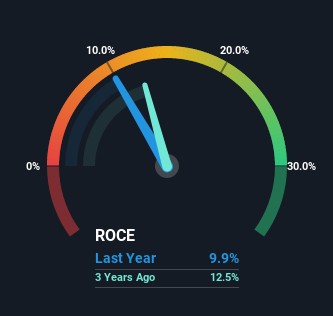[ad_1]
To find a multi-bagger stock, what are the underlying trends we should look for in a business? One common approach is to try and find a company with returns on capital employed (ROCE) that are increasing, in conjunction with a growing amount of capital employed. Basically this means that a company has profitable initiatives that it can continue to reinvest in, which is a trait of a compounding machine. In light of that, when we looked at Life Healthcare Group Holdings (JSE:LHC) and its ROCE trend, we weren’t exactly thrilled.
What Is Return On Capital Employed (ROCE)?
Just to clarify if you’re unsure, ROCE is a metric for evaluating how much pre-tax income (in percentage terms) a company earns on the capital invested in its business. The formula for this calculation on Life Healthcare Group Holdings is:
Return on Capital Employed = Earnings Before Interest and Tax (EBIT) ÷ (Total Assets – Current Liabilities)
0.099 = R2.8b ÷ (R38b – R9.8b) (Based on the trailing twelve months to March 2022).
Therefore, Life Healthcare Group Holdings has an ROCE of 9.9%. Ultimately, that’s a low return and it under-performs the Healthcare industry average of 19%.
See our latest analysis for Life Healthcare Group Holdings

In the above chart we have measured Life Healthcare Group Holdings’ prior ROCE against its prior performance, but the future is arguably more important. If you’d like to see what analysts are forecasting going forward, you should check out our free report for Life Healthcare Group Holdings.
The Trend Of ROCE
On the surface, the trend of ROCE at Life Healthcare Group Holdings doesn’t inspire confidence. To be more specific, ROCE has fallen from 25% over the last five years. Although, given both revenue and the amount of assets employed in the business have increased, it could suggest the company is investing in growth, and the extra capital has led to a short-term reduction in ROCE. And if the increased capital generates additional returns, the business, and thus shareholders, will benefit in the long run.
On a related note, Life Healthcare Group Holdings has decreased its current liabilities to 26% of total assets. So we could link some of this to the decrease in ROCE. What’s more, this can reduce some aspects of risk to the business because now the company’s suppliers or short-term creditors are funding less of its operations. Since the business is basically funding more of its operations with it’s own money, you could argue this has made the business less efficient at generating ROCE.
The Key Takeaway
Even though returns on capital have fallen in the short term, we find it promising that revenue and capital employed have both increased for Life Healthcare Group Holdings. These growth trends haven’t led to growth returns though, since the stock has fallen 13% over the last five years. So we think it’d be worthwhile to look further into this stock given the trends look encouraging.
Like most companies, Life Healthcare Group Holdings does come with some risks, and we’ve found 1 warning sign that you should be aware of.
For those who like to invest in solid companies, check out this free list of companies with solid balance sheets and high returns on equity.
Have feedback on this article? Concerned about the content? Get in touch with us directly. Alternatively, email editorial-team (at) simplywallst.com.
This article by Simply Wall St is general in nature. We provide commentary based on historical data and analyst forecasts only using an unbiased methodology and our articles are not intended to be financial advice. It does not constitute a recommendation to buy or sell any stock, and does not take account of your objectives, or your financial situation. We aim to bring you long-term focused analysis driven by fundamental data. Note that our analysis may not factor in the latest price-sensitive company announcements or qualitative material. Simply Wall St has no position in any stocks mentioned.
[ad_2]
Source link








